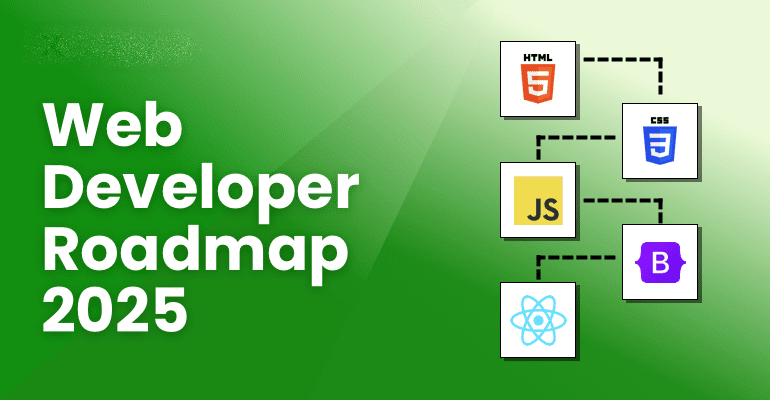Your Journey from Beginner to Professional Web Developer: The 2025 Roadmap

The web development landscape in 2025 is evolving faster than ever. The lines between frontend, backend, and DevOps are blurring as tools become more powerful and integrated. Becoming a professional web developer today requires more than just knowing HTML, CSS, and JavaScript — it demands a deep understanding of frameworks, architecture, cloud infrastructure, and performance optimization.
This roadmap will guide you step-by-step through the practical journey — from absolute beginner to full-stack professional — using 2025’s best tools and workflows.
1. Building a Strong Foundation
Before diving into frameworks, you must master the fundamentals that power everything on the web.
Core Languages to Master:
- HTML5: Understand semantic markup, accessibility (ARIA), and SEO-oriented structure.
- CSS3: Go beyond styling — learn Flexbox, Grid, and responsive design. Use CSS variables and custom properties for theming.
- JavaScript (ES2025+): Learn deep concepts like closures, promises, async/await, modules, destructuring, and new ES features like
Temporal, top-level await, and decorators.
Practical Step:
Build a static portfolio site without any framework, only HTML, CSS, and JS. Deploy it via GitHub Pages or Vercel.
2. Modern Frontend Development
Once you’re comfortable with JavaScript, move into modern frontend ecosystems. In 2025, frontend development revolves around three key ideas: componentization, reusability, and performance optimization.
Recommended Frameworks:
- React 19 (with Server Components): React has evolved into a hybrid rendering model where parts of your app can run on the server. Learn SSR, RSC, and hydration.
- Next.js 15: The de facto standard for production-grade React apps. Explore App Router, Server Actions, Edge Rendering, and Incremental Static Regeneration (ISR).
- Svelte 5 or SolidJS: Great for learning fine-grained reactivity and compiling directly to efficient JavaScript.
Hands-On Practice:
Build a dashboard application using Next.js:
- Use TypeScript for type safety.
- Integrate Tailwind CSS for fast, utility-first design.
- Fetch live data from an API using React Query (TanStack Query).
- Deploy on Vercel Edge Functions for low-latency responses.
3. Version Control and Collaboration
No professional developer works in isolation. Learn how to use Git and GitHub effectively.
Key Skills:
- Branching strategies (Git Flow, trunk-based).
- Writing conventional commits for clean history.
- Code review and pull requests.
- Continuous Integration (CI) via GitHub Actions or GitLab CI/CD.
Pro Tip: Automate linting and tests on every commit using tools like ESLint, Prettier, and Vitest.
4. Backend Mastery
To become a full-stack developer, you must understand the server side. In 2025, Node.js (with Bun or Deno) dominates backend JavaScript development, but Rust and Go are gaining traction for high-performance services.
Node.js and Express (or Fastify):
- Learn RESTful API design and versioning.
- Use JWT or OAuth 2.1 for authentication.
- Secure your endpoints with Helmet.js and input validation libraries like Zod.
Modern Backend Alternatives:
- tRPC or GraphQL for type-safe APIs.
- Drizzle ORM or Prisma for working with databases efficiently.
- PostgreSQL remains the go-to database; PlanetScale (MySQL) is great for serverless setups.
Hands-On Project:
Build a REST + GraphQL hybrid API that powers your Next.js dashboard. Add authentication and persistent user data.
5. DevOps, CI/CD, and Cloud Deployment
A professional developer must be comfortable shipping and maintaining apps in production.
Essential Tools:
- Docker: Containerize both frontend and backend.
- Kubernetes / Render / Fly.io: Orchestrate containers in scalable environments.
- Vercel / Netlify / Cloudflare Pages: For quick frontend deployments.
- GitHub Actions: Automate tests, builds, and deployments.
Observability Stack:
- Use Sentry for error tracking.
- Add Prometheus + Grafana for metrics.
- Monitor logs using Logtail or Elastic Stack (ELK).
Pro Tip:
Use Infrastructure as Code (IaC) with Terraform or Pulumi to version and automate your environment setup.
6. Testing and Quality Assurance
Testing is no longer optional — it’s part of the modern web workflow.
Testing Types to Master:
- Unit Testing: Using Vitest or Jest.
- Integration Testing: Using Playwright or Cypress.
- End-to-End (E2E): Automate user flows with Playwright’s headless mode.
- Performance Testing: Leverage Lighthouse CI or k6.
Hands-On Task:
Create a full CI pipeline where every PR triggers unit and E2E tests before merging to main.
7. Performance and Optimization
In 2025, Core Web Vitals remain crucial for SEO and user experience.
Optimization Checklist:
- Use Edge Caching (CDN) with Cloudflare or Vercel.
- Implement lazy loading for images and components.
- Analyze performance with WebPageTest and Lighthouse.
- Use bundle analyzers to minimize client-side JS.
Advanced Tip:
Adopt React Server Components + Edge Rendering to reduce TTFB (Time to First Byte) and improve hydration performance.
8. Advanced Topics for Professionals
Once you master the stack, explore these advanced frontiers:
- WebAssembly (WASM): Integrate compiled Rust modules into web apps.
- AI-assisted Development: Use GitHub Copilot X or Cursor IDE for intelligent code suggestions.
- Progressive Web Apps (PWA): Add offline mode, caching, and push notifications.
- Web Security: Understand CORS, CSRF, XSS, and Content Security Policies.
- Micro Frontends: Split large apps into manageable, deployable chunks.
9. Continuous Learning and Contribution
To stay relevant:
- Follow top dev blogs and YouTube channels (Fireship, Theo, Lee Robinson).
- Read RFCs and changelogs for frameworks you use.
- Contribute to open-source projects — even documentation updates count.
- Attend meetups or hackathons to stay sharp.
Final Thoughts
Becoming a professional web developer in 2025 isn’t about memorizing frameworks — it’s about understanding how web systems work together. The best developers automate workflows, measure performance, and never stop learning.
Your path won’t be linear, but every project will teach you something new. Focus on building real projects, experimenting with modern tools, and writing clean, maintainable code.
The web is evolving — make sure you evolve with it. 🌐

